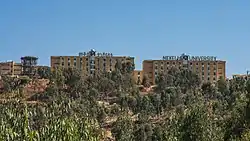Mekelle University
Mekelle University (Tigrinya: መቐለ ዩኒቨርሲቲ) is a higher education and training public institution located in Mekelle, Tigray, Ethiopia, 783 kilometers north of Ethiopia's capital, Addis Ababa. Mekelle University is one of the largest public universities in Ethiopia. It has seven colleges, eight institutes, and more than 90 undergraduate and 70 postgraduate programs.[4] The student intake capacity of Mekelle University has reached 31,000 or 10% of Mekelle's population.
መቐለ ዩኒቨርስቲ | |
.png.webp) | |
| Established | 1993 |
|---|---|
| President | Professor Fetien Abay[1][2] |
| Students | 29,617 (2013/14)[3] |
| Location | , 13°28′48″N 39°29′06″E |
| Language | English |
| Website | www |
History

The Arid Zone Agricultural College was established at the University of Asmara, but was then moved to Agarfa in southern Ethiopia in 1990. In 1993, the Arid Zone Agricultural College was moved to Mekelle and started with 42 students in 3 degree programs. After two years, the Faculty of Science and Technology was established at the same campus and, together, these two faculties were then combined into Mekelle University College. Also, a Faculty of Law started its operation by accepting diploma students through a continuing education program.
In May 2000, the Government of Ethiopia (Council of Ministers, Regulations No. 61/1999 of Article 3) formalized Mekelle University as an autonomous higher education institution. Professor Mitiku Haile became the first president.[4]
During the 2020-2021 Tigray War, attacks were carried out on Mekelle University by the joint Ethiopian and Eritrean armies, including aerial bombardments in which students were wounded. On 18 December 2020, according to EEPA, Mekelle University announced a graduation ceremony of students, pictures online were from previous years. Staff at the university were reporting back to work. [5]
Academics
Presidents
- Professor Mitiku Haile (2000-2010)
- Professor Joachim Herzig (2010-2013)
- Professor Kindeya Gebrehiwot (2013-2020)[6]
- Professor Fetien Abay (2020-ongoing)[1][2]
Colleges
- College of Dryland Agriculture and Natural Resources Management
- College of Natural and Computational Sciences
- College of Law and Governance
- College of Social Sciences and Languages
- College of Business and Economics
- College of Health Sciences and Ayder Referral Hospital
- College of Veterinary science/http://www.mu.edu.et/cvs/
Institutes
- Ethiopian Institute of Technology - Mekelle (EiT-M)
- Institute of Paleo-Environment and Heritage Conservation
- Institute of Geo-Information and Earth Observation
- Institute of Environment, Gender, and Development Studies
- Institute of Water and Environment
- Institute of Climate and Society
- Institute of Pedagogical Sciences
- Institute of Energy (IoE)
- Mekelle Institute of Technology (MIT-MU)
- Sports Science Academy and Mekelle Stadium (under construction)
- Ethiopian mechanical engineering society (under construction)
Development of the Main Campus
A village existed at the edge of the escarpment overlooking Mekelle. On a nearby hill, the Iyesus church was established. The villagers fetched their water from the May Anishti spring underneath. In 1895, a fort was established on the small hill overlooking the campus, and the place served as a military stronghold, that was conquered by the Italian army in 1935. In 1938, there was a shop-restaurant, a post, telephone and telegraph office, an Italian military post and a military cemetery.[7] In 1938, the village of Inda Iyesus counted approximately 350 inhabitants (including 45 Italians).[7] After the Italian defeat in 1941, the place was taken over by the Ethiopian army, who expanded it into a large military camp. After the defeat of the Derg army in 1989, the place was used for a few years by the TPLF army after which it was transferred to the Ministry of Education for the establishment of the "Arid Zone College" that would gradually grow into Mekelle University. Popular names of the campus are taken from this history: Arid Campus and Inda Iyesus Campus.
Parks
Mekelle University main campus hosts several parks:
- Momona Park, called after a large momona tree (Faidherbia albida) under which the first lectures were organised in the academic year 1993-1994
- Belgium Park, in reference to the longstanding cooperation with the Belgian academic institutions (starting 1994)
- The large May Anishti forest on the slope between campus and city. It hosts a wide range of wild animals[8] including Crocuta crocuta, spotted hyena, ዝብኢ (zibi) - Caracal caracal, caracal, ጭክ ኣንበሳ (ch’ok anbessa) - Panthera pardus, leopard, ነብሪ (nebri)[9] - Xerus rutilus, unstriped ground squirrel, ምጹጽላይ or ጨጨራ (mitsutsilay, chechera) - Canis mesomelas, black-backed jackal, ቡኳርያ (bukharya) - Canis anthus, golden jackal, ቡኳርያ (bukharya) - Procavia capensis, rock hyrax, ጊሐ (gihè) - Felis silvestris, African wildcat, ሓክሊ ድሙ (hakili dummu) - Civettictis civetta, African civet, ዝባድ (zibad) - Ichneumia albicauda, white-tailed mongoose, ፂሒራ (tsihira) - Herpestes ichneumon, large grey mongoose, ፂሒራ (tsihira) - Hystrix cristata, crested porcupine, ቅንፈዝ (qinfiz) - Genetta genetta, common genet, ስልሕልሖት (silihlihot) - Lepus capensis, cape hare, ማንቲለ (mantile) - Mellivora capensis, honey badger, ትትጊ (titigi)
Notable people
- Samuel Urkato, Minister of Science and Higher Education.[10]
References
- AWARD Fellow becomes female University President in Ethiopia
- Profile: Emergence of women-led universities in Ethiopia Addis Standard, 16 October 2020
- http://www.mu.edu.et/index.php/information-managment/473-mu-2006e-c-students-statistics%5B%5D
- "General Information As of January 1, 2018". Mekelle University. Retrieved 6 October 2018.
- Situation Report EEPA HORN No. 30 - 19 December Europe External Programme with Africa
- Mekelle University Board Approves Full Professorship Promotion of Dr. Kindeya Gebrehiwot and Dr. Gidey Yirga EthioGRI, 2/8/2017, Sandra Turner
- Consociazione turistica Italiana. Guida dell'Africa orientale Italiana. Milano. p. 301.
- Aerts, Raf (2019). Forest and woodland vegetation in the highlands of Dogu'a Tembien. In: Geo-trekking in Ethiopia's Tropical Mountains - The Dogu'a Tembien District. SpringerNature. ISBN 978-3-030-04954-6. Retrieved 18 June 2019.
- Westerberg, M.; Craig, E.; Meheretu Yonas (2018). "First record of African leopard (Panthera pardus pardus L.) in semi‐arid area of Yechilay, northern Ethiopia". African Journal of Ecology. 56 (2): 375–377. doi:10.1111/aje.12436.
- "H.E. Dr Samuel Urkato". Aogeac.com. Retrieved 8 December 2020.